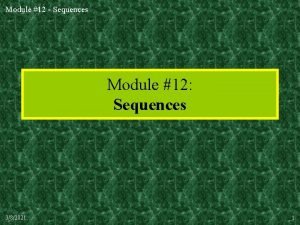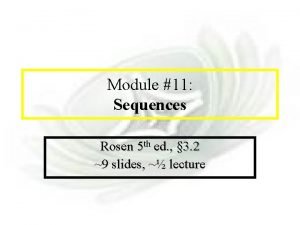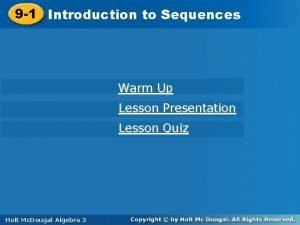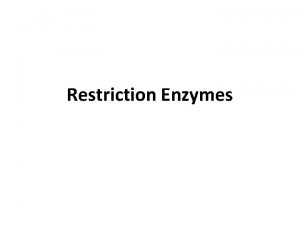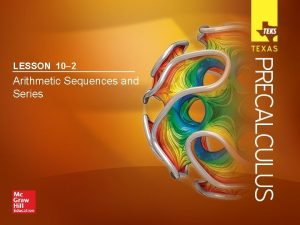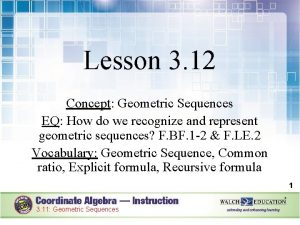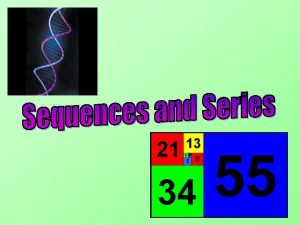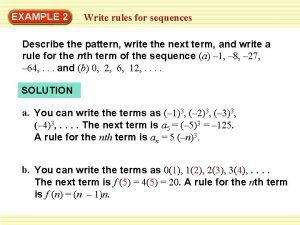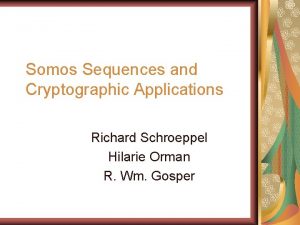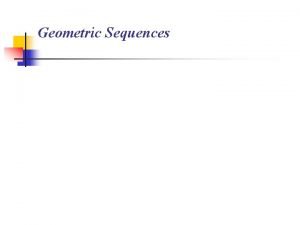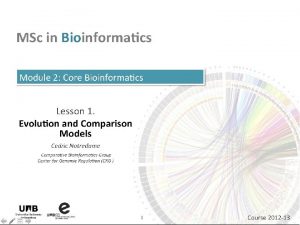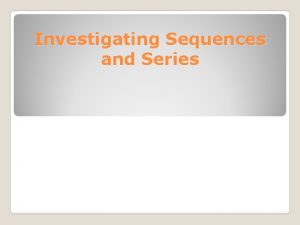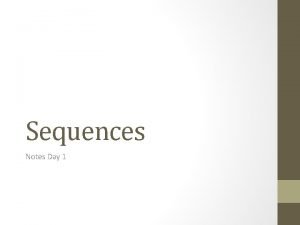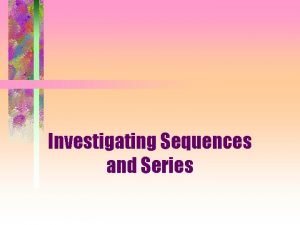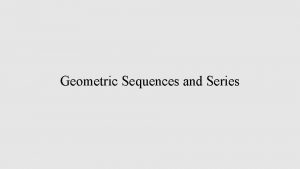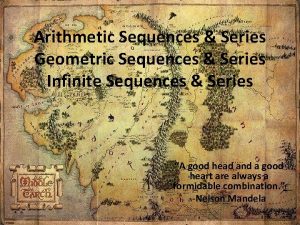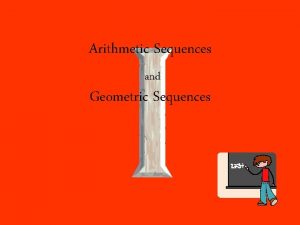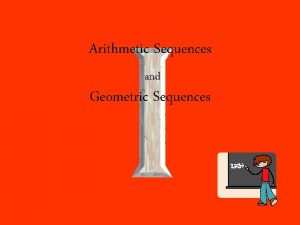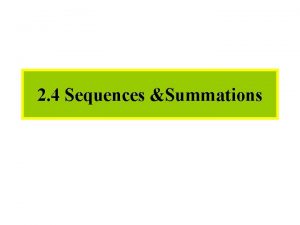Module 12 Sequences Module 12 Sequences 382021 1












- Slides: 12

Module #12 - Sequences Module #12: Sequences 3/8/2021 1

Module #12 - Sequences § 3. 2: Sequences, Strings, & Summations • A sequence or series is just like an ordered ntuple, except: – Each element in the series has an associated index number. – A sequence or series may be infinite. • A string is a sequence of symbols from some finite alphabet. • A summation is a compact notation for the sum of all terms in a (possibly infinite) series. 3/8/2021 2

Module #12 - Sequences • A sequence or series {an} is identified with a generating function f: S A for some subset S N and for some set A. – Often we have S=N or S=N+{0}. – Sequences may also be generalized to indexed sets, in which the set S does not have to be a subset of N. • For general indexed sets, S may not even be a set of numbers at all. • If f is a generating function for a series {an}, then for n S, the symbol an denotes f(n), also called term n of the sequence. – The index of an is n. (Or, often i is used. ) • A series is sometimes denoted by listing its first and/or last few elements, and using ellipsis (…) notation. – E. g. , “{an} = 0, 1, 4, 9, 16, 25, …” is taken to mean n N, an = n 2. 3/8/2021 3

Module #12 - Sequences Sequence Examples • Some authors write “the sequence a 1, a 2, …” instead of {an}, to ensure that the set of indices is clear. – Be careful: Our book often leaves the indices ambiguous. • An example of an infinite series: – Consider the series {an} = a 1, a 2, …, where ( n 1) an= f(n) = 1/n. – Then, we have {an} = 1, 1/2, 1/3, … 3/8/2021 4

Module #12 - Sequences Example with Repetitions • Like tuples, but unlike sets, a sequence may contain repeated instances of an element. • Consider the sequence {bn} = b 0, b 1, … (note that 0 is an index) where bn = ( 1)n. – Thus, {bn} = 1, 1, … • Note repetitions! – This {bn} denotes an infinite sequence of 1’s and 1’s, not the 2 -element set {1, 1}. 3/8/2021 5

Module #12 - Sequences are two types: • Geometric progression: it is a sequence of form a, ar 2, ar 3 ………, arn where the initial term is a and the common ratio r are real numbers. • Arithmetic progression: it is a sequence of form a, a+d, a+2 d, ………, a + nd where the initial term a and the common difference d are real numbers 3/8/2021 6

Module #12 - Sequences Examples of Geometric • {bn } with bn = (-1)n n>=1 • An = -1, 1, ……. . – initial term = -1, common ratio= -1, – an=(-1)n , n=1, 2, 3, … • Cn = 10, 50, 250, 1250, ………. – initial term = 10, common ratio= 5 – an=10 (5)n , n=0, 1, 2, 3, … – an=5 x an-1 , n=0, 1, 2, 3, … 3/8/2021 7

Module #12 - Sequences Examples of Arithmetic • {Sn} with Sn = -1 + 4 n, n ≥ 0 is arithmetic sequence where Sn = -1, 3, 7, 11, … OR Sn = an-1+4, S 0=-1, n ≥ 0 – initial term = -1, common Difference= 4 • The sequence : 5, 11, 17, 23, 29 … an = 6 n – 1 , n ≥ 1 is arithmetic progression with a= 5, and d= 6 3/8/2021 8

Module #12 - Sequences Recognizing Sequences • Sometimes, you’re given the first few terms of a sequence, – and you are asked to find the sequence’s generating function, – or a procedure to enumerate the sequence. • Examples: What’s the next number? – 1, 2, 3, 4, … – 1, 3, 5, 7, 9, … – 2, 3, 5, 7, 11, . . . 3/8/2021 5 (the 5 th smallest number >0) 11 (the 6 th smallest odd number >0) 13 (the 6 th smallest prime number) 9

Module #12 - Sequences The Trouble with Sequence Recognition • As you know, these problems are popular on IQ tests, but… • The problem of finding “the” generating function given just an initial subsequence is not a mathematically well defined problem. – This is because there are infinitely many computable functions that will generate any given initial subsequence. • We implicitly are supposed to find the simplest such function (because this one is assumed to be most likely), but, – how are we to objectively define the simplicity of a function? • We might define simplicity as the reciprocal of complexity, but… – There are many different plausible, competing definitions of complexity, and this is an active research area. • So, these questions really have no objective right answer! – Still, we will ask you to answer them anyway… (Because others will too. ) 3/8/2021 10

Module #12 - Sequences Strings, more formally • Let be a finite set of symbols, i. e. an alphabet. – A string s over alphabet is any sequence {si} of symbols, si , indexed by N or N {0}. • If a, b, c, … are symbols, the string s = a, b, c, … can also be written abc …(i. e. , without commas). • If s is a finite string and t is any string, then the concatenation of s with t, written just st, – is simply the string consisting of the symbols in s, in sequence, followed by the symbols in t, in sequence. 3/8/2021 11

Module #12 - Sequences More Common String Notations • The length |s| of a finite string s is its number of positions (i. e. , its number of index values i). • If s is a finite string and n N, – Then sn denotes the concatenation of n copies of s. • denotes the empty string, the string of length 0. 3/8/2021 12
 Module 12 sequences and series answers
Module 12 sequences and series answers Module 4 patterns and sequences
Module 4 patterns and sequences Patterns and sequences module quiz b
Patterns and sequences module quiz b C device module module 1
C device module module 1 Molecular scissors
Molecular scissors 10-2 practice arithmetic sequences and series
10-2 practice arithmetic sequences and series Lesson 3: arithmetic and geometric sequences
Lesson 3: arithmetic and geometric sequences Sequences and series
Sequences and series How to write rules for sequences
How to write rules for sequences Richard schroeppel
Richard schroeppel What's a geometric sequence
What's a geometric sequence Infinitif ou subjonctif reliez les deux sequences
Infinitif ou subjonctif reliez les deux sequences Compare two protein sequences
Compare two protein sequences
